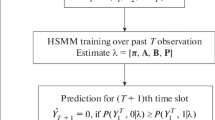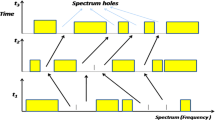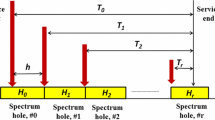Abstract
Dynamic Spectrum Access (DSA)/Cognitive Radio (CR) systems access the channel in an opportunistic, non-interfering manner with the primary network. DSA/CR systems utilize spectrum sensing techniques to sense the availability of Primary user (PU). CR users can benefit from the knowledge of PU activity statistics. In this work, comprehensive analysis of estimation of distribution of PU idle and busy periods is carried out using Generalized Pareto and Pareto distributions for long and short time scale models respectively and closed form expression is derived. Moreover, the impact of sensing periods on the accuracy of estimated PU idle/busy periods is studied. Furthermore, the error in proposed estimation of distribution of PU idle and busy periods is quantified using the Kolmogorov–Smirnov test. From this study we conclude that the proposed model is better fit for the real scenarios eliminating practical limitations. Mathematical analysis is substantiated with the simulation results.






Similar content being viewed by others
References
Lundén, J., Koivunen, V., & Poor, H. V. (2015). Spectrum exploration and exploitation for cognitive radio: Recent advances. IEEE Signal Processing Magazine, 32(3), 123–140.
Cardenas-juarez, M., Diaz-ibarra, M. A., Pineda-rico, U., Arce, A., & Stevens-navarro, E. (2016). On Spectrum occupancy measurements at 2. 4 GHz ISM Band for cognitive radio applications. In International Conference on Electronics, Communications and Computers (pp. 25–31).
Eze, J., Zhang, S., Liu, E., & Eze, E. (Sep. 2017). Cognitive radio technology assisted vehicular ad-hoc networks (VANETS): Current status, challenges, and research trends. In 2017 23rd International Conference on Automation and Computing (ICAC) (pp. 1–6).
Liang, Y. C., Chen, K. C., Li, G. Y., & Mähönen, P. (2011). Cognitive radio networking and communications: An overview. IEEE Transactions on Vehicular Technology, 60(7), 3386–3407.
Urkowitz, H. (1967). Energy detection of unknown deterministic signals. Proceedings of IEEE, 55(4), 523–531.
Chen, Y., & Oh, H. S. (2016). A survey of measurement-based spectrum occupancy modeling for cognitive radios. IEEE Communications Surveys and Tutorials, 18(1), 848–859.
Digham, F. F., Alouini, M. S., & Simon, M. K. (2007). On the energy detection of unknown signals over fading channels. IEEE Transactions on Communications, 55(1), 21–24.
Ahmadi, H., Chew, Y. H., Tang, P. K., & Nijsure, Y. A. (Sep. 2011). Predictive opportunistic spectrum access using learning based hidden markov models. In Proceedings of PIMRC, (pp. 401–405).
Ahmadi, H., Macaluso, I., & DaSilva, L. A. (June 2013). The effect of the spectrum opportunities diversity on opportunistic access. In IEEE International Conference on Communications (ICC) (pp. 2829–2834).
Macaluso, I., Ahmadi, H., & DaSilva, L. A. (2015). Fungible orthogonal channel sets for multi-user exploitation of spectrum. IEEE Transactions on Wireless Communications, 14(4), 2281–2293.
Liu, Y., & Tewfik, A. (June 2012). Hyperexponential approximation of channel idle time distribution with implication to secondary transmission strategy. In Proceedings of IEEE ICC (pp. 1800–1804).
Liu, C., Pawelczak, P., & Cabric, D. (2014). Primary user traffic classification in dynamic spectrum access networks. IEEE Journal on Selected Areas in Communications, 32(11), 2237–2251.
Shabara, Y., Zahran, A. H., & ElBatt, T. (June 2015). Efficient spectrum access strategies for cognitive networks with general idle time statistics. In Proceedings of IEEE ICC (pp. 7743–7749).
Agarwal, A., Dubey, S., Khan, M. A., Gangopadhyay, R., & Debnath, S. (June 2016). Learning based primary user activity prediction in cognitive radio networks for efficient dynamic spectrum access. In Proceedings SPCOM (pp. 1–5).
Al-Tahmeesschi, A., Lopez-Benitez, M., Lehtomaki, J., & Umebayashi, K. (March 2017). Investigating the estimation of primary occupancy patterns under imperfect spectrum sensing. In Proceedings of IEEE WCNC (pp. 1–6).
Al-Tahmeesschi, A., López-Benítez, M., Umebayashi, K., & Lehtomäki, J. (Oct 2017). Analytical study on the estimation of primary activity distribution based on spectrum sensing. In Proceedings of IEEE PIMRC (pp. 1–5).
Al-Tahmeesschi, A., López-Benítez, M., Lehtomäki, J., & Umebayashi, K. (April 2018). Accurate estimation of primary user traffic based on periodic spectrum sensing. In Proceedings of IEEE WCNC (pp. 1–6).
Al-Tahmeesschi, A, López-Benítez, M., Lehtomäki, J., Umebayashi, K. (April 2018). Improving primary statistics prediction under imperfect spectrum sensing. In Proceedings of IEEE WCNC (pp. 1–6).
López-Benítez, M., & Casadevall, F. (2013). Time-dimension models of spectrum usage for the analysis, design, and simulation of cognitive radio networks. IEEE Transactions on Vehicular Technology, 62(5), 2091–2104.
Larsen, R. J., Marx, M. L., et al. (1986). An introduction to mathematical statistics and its applications (Vol. 2). Englewood Cliffs, NJ: Prentice-Hall.
López-Benítez, M., & Casadevall, F. (June 2011). Modeling and simulation of time-correlation properties of spectrum use in cognitive radio. In 6th International ICST Conference on Cognitive Radio Oriented Wireless Networks and Communications (CROWNCOM) (pp. 326–330).
Johnson, N. L., Kotz, S., & Balakrishnan, N. (1995). Continuous univariate distributions, Vol. 2 of wiley series in probability and mathematical statistics: Applied probability and statistics.
Press, W. H., Teukolsky, S. A., Vetterling, W. T., & Flannery, B. P. (2007). Numerical recipes 3rd edition: The art of scientific computing (Vol. 3). Cambridge: Cambridge University Press.
Zwillinger, D. (2014). Table of integrals, series, and products (8th ed.). Amsterdam: Elsevier.
W. R. Inc. (2018) Mathematica online, Version 11.3, Champaign, IL
López-Benítez, M., Casadevall, F., Umbert, A., Pérez-Romero, J., Hachemani, R., Palicot, J., & Moy, C. (2009). Spectral occupation measurements and blind standard recognition sensor for cognitive radio networks. In Proceedings IEEE CROWNCOM (pp. 1–9).
Chu, X., Lopez-Perez, D., Yang, Y., & Gunnarsson, F. (2013). Heterogeneous Cellular Networks: Theory, Simulation and Deployment, Cambridge University Press.
Acknowledgements
This work is supported by Department of Science and Technology (DST)-UKIERI Programme under the Grant Ref. DST/INT/UK/P-150/2016. The authors would like to thank School of Engineering and Applied Science, Ahmedabad University and the University of Liverpool, UK for the infrastructural support.
Author information
Authors and Affiliations
Corresponding author
Additional information
Publisher's Note
Springer Nature remains neutral with regard to jurisdictional claims in published maps and institutional affiliations.
Appendices
Appendix 1: Derivation of the combined error \(T_e\)
Case 1 : \(t < -T_s\)
No overlap in both the distributions, i.e. \(f_{T^{y}_{e}}(\tau )\) and \(f_{-T^{x}_{e}}(t-\tau )\).
Case 2 :\(-T_s \le t < 0\)
Case 3 :\(0 \le t \le T_s\)
Case 4 :\(t > T_s\) No overlap in both the distributions, i.e. \(f_{T^{y}_{e}}(\tau )\) and \(f_{-T^{x}_{e}}(t - \tau )\).
Appendix 2: Derivation of PDF of estimated periods for generalized Pareto Distribution
Case 1 : \(t + T_s< \mu \implies t < \mu - T_s\)
No overlap in both the distributions, i.e. \(f_{T_i}(\tau )\) and \(f_{T_e}(t-\tau )\).
Case 2 :\(\mu - T_s \le t < \mu \)
Solving both the above integrals separately and combining them, we get,
Case 3 :\(\mu \le t \le \mu + T_s\)
Solving the above integrals separately and combining them, we get,
Case 4 :\(t > \mu + T_s\)
Solving the above two integrals and combining them, we get,
Appendix 3 : Derivation of CDF of estimated periods for generalized Pareto Distribution
Case 1 : \(t < \mu - T_s\)
Substituting the PDF derived in Case 1 of “Appendix 8”, we get,
Case 2 :\(\mu - T_s \le t < \mu \)
Solving the above integrals by substituting the appropriate PDFs derived for Case 1 and Case 2 in “Appendix 8” and combining them, we get,
Case 3 :\(\mu \le t \le \mu + T_s\)
Solving the above integrals by substituting the appropriate PDFs derived for Case 1, Case 2 and Case 3 in “Appendix 8” and combining them, we get,
Case 4 :\(t > \mu + T_s\)
Solving the above integrals by substituting the appropriate PDFs derived for Case 1, Case 2, Case 3 and Case 4 in “Appendix 8” and combining them, we get,
Appendix 4: Derivation of PDF of estimated periods for Pareto distribution
Case 1 : \(t + T_s< \mu \implies t < \mu - T_s\)
No overlap in both the distributions, i.e. \(f_{T_i}(\tau )\) and \(f_{T_e}(t-\tau )\).
Case 2 :\(\mu - T_s \le t < \mu \)
On solving the above integral, we get
Case 3 :\(\mu \le t \le \mu + T_s\)
Solving the above integrals separately and combining them, we get,
Case 4 :\(t > \mu + T_s\)
Solving the above two integrals and combining them, we get,
Appendix 5: Derivation of CDF of estimated periods for Pareto distribution
Case 1 :\(t < \mu - T_s\) Substituting the PDF derived in Case 1 of “Appendix 10”, we get,
Case 2 :\(\mu - T_s \le t < \mu \)
Solving the above integrals by substituting the appropriate PDFs derived for Case 1 and Case 2 in “Appendix 10” and combining them, we get,
Case 3 :\(\mu \le t \le \mu + T_s\)
Solving the above integrals by substituting the appropriate PDFs derived for Case 1, Case 2 and Case 3 in “Appendix 10” and combining them, we get,
Case 4 :\(t > \mu + T_s\)
Solving the above integrals by substituting the appropriate PDFs derived for Case 1, Case 2, Case 3 and Case 4 in “Appendix 10” and combining them, we get,
Rights and permissions
About this article
Cite this article
Patel, D.K., Soni, B. & López-Benítez, M. On the estimation of primary user activity statistics for long and short time scale models in cognitive radio. Wireless Netw 25, 5099–5111 (2019). https://doi.org/10.1007/s11276-019-02118-z
Published:
Issue Date:
DOI: https://doi.org/10.1007/s11276-019-02118-z




